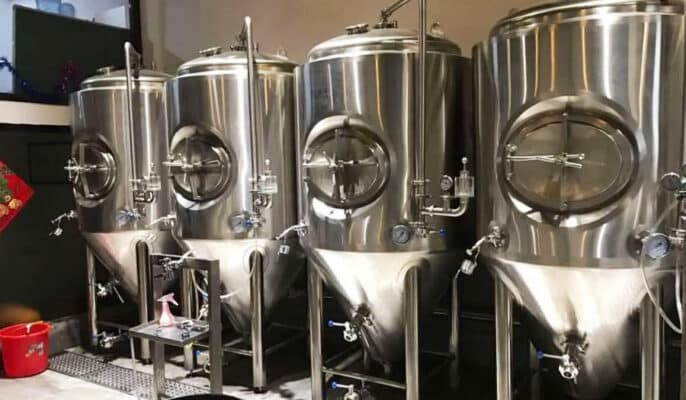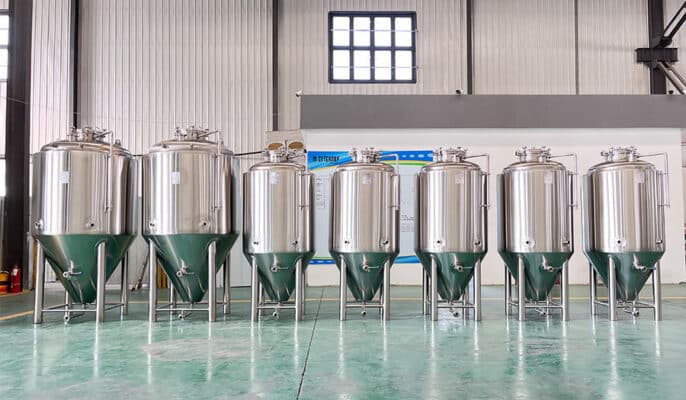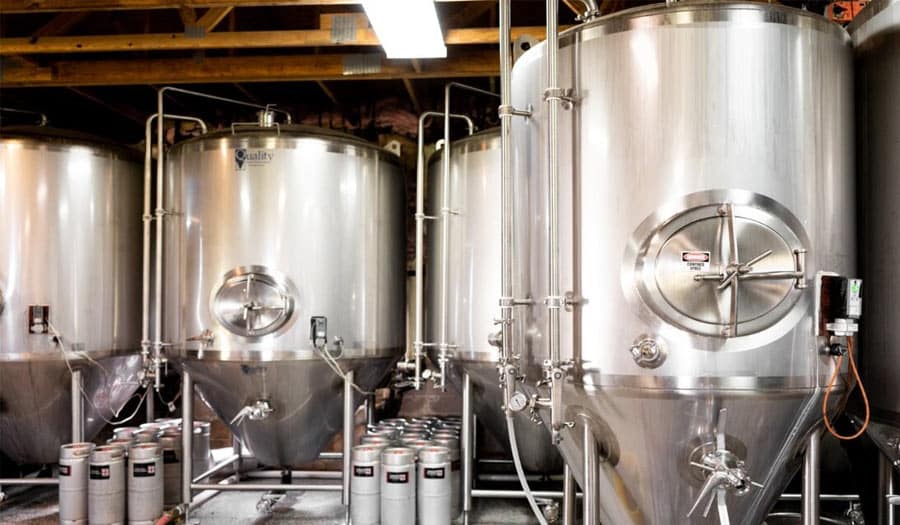Fermenters are vital in various industries, from biotechnology to food and beverage production. Understanding their basic functions is essential to understanding their importance in these applications. Fermenters are indispensable equipment in modern biotechnology and food industries. Their main function is to provide a suitable growth environment for microorganisms to carry out various fermentation processes. This article will explore the main uses of fermenters in winemaking in detail, including their working principles, design features, and applications in the production of different types of wine.
Basic Concepts of Fermentation
Before we delve into the uses of fermentation vessels, we first need to clarify the basic concepts of fermentation. Fermentation is a biochemical process, usually catalyzed by yeast, bacteria, or other microorganisms. In this process, yeast converts sugar into alcohol and carbon dioxide, while producing various flavor and aroma compounds. In the winemaking process, fermentation is not only the process of producing alcohol but also a key link in giving the wine its unique flavor and taste.
Fermentation is divided into several stages, including:
- Primary fermentation: In this stage, yeast begins to proliferate rapidly, consuming available sugars and producing alcohol and carbon dioxide.
- Stable fermentation: As sugar decreases, yeast activity begins to slow down and the fermentation rate decreases.
- Secondary fermentation: Usually carried out after the primary fermentation, the wine is transferred to remove sediment, thereby improving clarity and taste.

How a fermenter works
The basic function of a fermenter is to promote the fermentation process of sugar by yeast by controlling a series of environmental factors. During this process, yeast converts sugar into alcohol, carbon dioxide, and a variety of flavor compounds, which ultimately form the flavor and characteristics of the wine.
Conversion of sugar to alcohol
One of the main functions of a fermenter in the winemaking process is to encourage yeast to convert sugar in the raw materials into alcohol. This process is divided into several steps:
- Raw material preparation: The raw materials used for winemaking, such as grapes, malt, or other sugar sources, are washed, crushed, and extracted to obtain a sugar solution (such as grape juice or maltose water).
- Inoculation of yeast: Yeast is added to the prepared sugar solution. The type and amount of yeast will directly affect the fermentation speed and the quality of the product.
- Fermentation process: Yeast begins to multiply at a suitable temperature and pH value, metabolizing sugar and converting it into alcohol and carbon dioxide. This process usually lasts from a few days to a few weeks, depending on the type of wine produced and the type of yeast.
Environmental control
Fermenters are usually equipped with advanced control systems to maintain and monitor the environmental conditions required during the fermentation process. These conditions include:
- Temperature control: Different wines and yeast varieties have different temperature requirements. Most winemaking processes are carried out between 15-25°C to promote yeast activity and reduce the production of unpleasant flavors.
- pH monitoring: pH affects yeast growth and fermentation results, and is usually kept between 3.0-4.0 for best results.
- Oxygen management: In the early stages of fermentation, yeast requires oxygen to reproduce; in the later stages of fermentation, oxygen needs to be restricted to prevent alcohol oxidation and the production of off-flavors.
Agitation and mixing
The agitation system inside the fermentation tank is designed to promote the uniformity of the culture medium and the dissolution of oxygen. Through effective agitation:
- Increase the content of dissolved oxygen: In the early stages of fermentation, agitation helps to effectively dissolve oxygen into the liquid and promote yeast reproduction.
- Ensure uniformity: Agitation can evenly mix the sugar solution with the yeast, ensuring that the yeast can fully contact the sugar, thereby improving fermentation efficiency.

Fermentation tank design features
- Material selection: Fermentation tanks are usually made of materials such as stainless steel, glass, or plastic to ensure their corrosion resistance and easy cleaning. Stainless steel fermentation tanks are widely used because of their durability and hygiene.
- Sealing system: A good sealing design can prevent external contamination while allowing carbon dioxide to be released. Modern fermentation tanks are usually equipped with gas valves to release gas during fermentation without allowing outside air to enter.
- Temperature control system: Fermentation tanks are usually equipped with temperature control devices, including heating and cooling systems, to ensure that the fermentation temperature remains within the optimal range.
- Monitoring instruments: Various sensors and monitoring equipment are installed in the fermentation tank, which can monitor key parameters such as temperature, pH value, and dissolved oxygen content in real-time to ensure the stability and safety of the winemaking process.
- Ease of cleaning: To prevent contamination and maintain hygiene, the design of the fermentation tank should be easy to clean and disinfect. Many fermentation tanks are equipped with CIP (cleaning in place) systems for efficient cleaning.
Application of fermentation tanks in different types of alcohol
Beer Brewing
Using a dedicated primary fermentation tank, yeast converts the sugar in the malt into alcohol and carbon dioxide at this stage, which usually lasts for 1-2 weeks. After the primary fermentation is completed, the beer is transferred to the secondary fermentation tank (or maturation tank) to further develop the flavor and aroma at this stage, which can last up to several months. Different types of beer (such as lager, and ale) have different temperature requirements, and brewers need to adjust accordingly according to the type of beer.
Wine brewing
Temperature-controlled fermentation is often used, and the temperature is maintained at 12-18°C to protect aromatic substances. The fermentation tanks for red wine are usually larger, allowing the wine to contact the grape skins to extract color and tannins, and the fermentation temperature is generally between 20-30°C. Some high-end wines are fermented in oak barrels to further enhance their flavor and complexity.
Sake brewing
The sake brewing process includes simultaneous saccharification and fermentation, and special fermentation tanks are used to ensure the smooth progress of this process. The fermentation of sake has high requirements for temperature and humidity and usually needs to be carried out in a low-temperature and high-humidity environment to improve the fermentation effect.

What is the main purpose of a fermentation tank?
Provide a suitable fermentation environment
The main function of a fermentation tank is to provide a suitable fermentation environment for yeast, including controlling temperature, humidity, oxygen content, etc., to ensure that the yeast works in the best condition. Yeast is very sensitive to environmental conditions. Too high or too low a temperature will affect its activity, which in turn affects the fermentation efficiency and the quality of the final product.
Prevent pollution
The design of the fermentation container should ensure that external contaminants are prevented from entering. Open containers are easily contaminated by microorganisms in the air, resulting in fermentation failure or unpleasant taste. The sealed design of closed containers can effectively reduce the risk of contamination and protect the purity of brewing.
Control the release of fermentation gases.
During the fermentation process, yeast produces carbon dioxide. The fermentation tank needs to have a certain amount of ventilation to allow carbon dioxide to escape safely, but at the same time, it cannot let outside air in. Many modern fermenters are equipped with air valves, which are specially designed to release gas but keep air and impurities out.
Promote flavor development
The material and design of the fermentation container will affect the flavor of beer or other fermented beverages. For example, stainless steel containers can maintain the pure flavor of the beverage, while wooden barrels can give the body a unique aroma and flavor component. When choosing a fermentation vessel, brewers need to consider its potential impact on the flavor of the final product.
Easy to clean and maintain
The fermentation vessel needs to be easy to clean and sanitize to prevent the growth of bacteria and impurities. Any residue or dirt may affect the fermentation process and the quality of the final product. Therefore, it is crucial to choose a well-designed and easy-to-clean vessel.
Support for temperature control
Some fermenters come with built-in temperature control systems to maintain a constant fermentation temperature. Proper temperature control is essential for yeast activity and fermentation results. Especially when brewing a specific style of beer, small temperature changes can lead to significant differences in flavor.
FAQ
What is a fermenter?
A fermenter is a specially designed container used to control and optimize the microbial fermentation process and is commonly used in the production of wine, dairy products, pharmaceuticals, and biofuels.
How does a fermenter affect product quality?
The design and control parameters of the fermenter (such as temperature, pH, and oxygen) directly affect the growth and metabolism of microorganisms, which in turn affect the taste, aroma, and quality of the final product.
What are the main uses of a fermenter?
- Convert sugars into alcohol and other fermentation products.
- Control environmental parameters such as temperature, pH, and dissolved oxygen during the fermentation process.
- Provide appropriate agitation and mixing to improve fermentation efficiency.
- Prevent contamination and ensure product safety.




